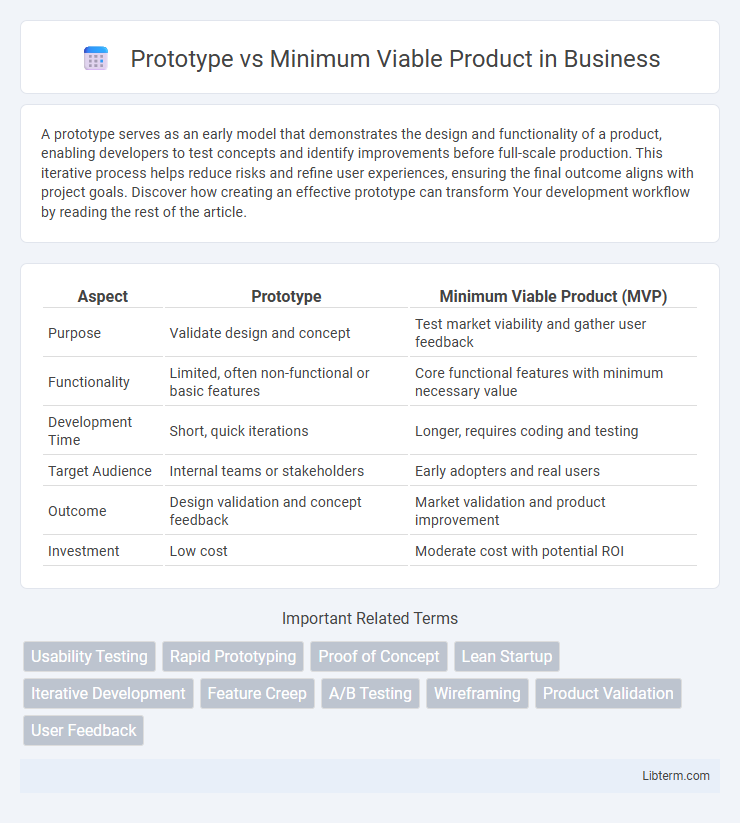A prototype serves as an early model that demonstrates the design and functionality of a product, enabling developers to test concepts and identify improvements before full-scale production. This iterative process helps reduce risks and refine user experiences, ensuring the final outcome aligns with project goals. Discover how creating an effective prototype can transform Your development workflow by reading the rest of the article.
Table of Comparison
| Aspect | Prototype | Minimum Viable Product (MVP) |
|---|---|---|
| Purpose | Validate design and concept | Test market viability and gather user feedback |
| Functionality | Limited, often non-functional or basic features | Core functional features with minimum necessary value |
| Development Time | Short, quick iterations | Longer, requires coding and testing |
| Target Audience | Internal teams or stakeholders | Early adopters and real users |
| Outcome | Design validation and concept feedback | Market validation and product improvement |
| Investment | Low cost | Moderate cost with potential ROI |
Understanding Prototype and Minimum Viable Product
A prototype is an early, often incomplete model of a product designed to visualize concepts and gather user feedback on form and functionality without full backend development. A Minimum Viable Product (MVP) is a functional version with core features built to test market demand and validate assumptions while minimizing development time and cost. Understanding the distinction helps guide product strategy by balancing exploratory design and practical market validation.
Key Differences Between Prototype and MVP
A prototype is an early sample or model built to test a concept or process, primarily focusing on design validation and user interface feedback without requiring full functionality. In contrast, a Minimum Viable Product (MVP) is a functional version of the product containing only core features necessary to satisfy early adopters and gather actionable user insights for further development. Prototypes emphasize exploration and iteration, while MVPs prioritize market entry and real-world usability testing.
Purpose and Goals: Prototype vs MVP
A prototype serves as an early model used to visualize and test design concepts, enabling rapid feedback on functionality and user experience before full development. The primary goal of a prototype is to validate ideas and identify potential issues quickly, often lacking full features or scalability. A Minimum Viable Product (MVP) aims to launch a functional product with the essential features necessary to satisfy early adopters and gather real-world user data for iterative improvement and market validation.
Stages of Development: When to Use Each
Prototypes serve early development stages to visualize concepts, validate ideas, and gather user feedback quickly with minimal features and low cost. Minimum Viable Products (MVPs) are used in later stages to launch a functional product with core features, test market viability, and collect data for iterative improvements. Use prototypes during ideation and design validation, while MVPs are crucial before full-scale product development and market entry.
Design and Functionality Comparison
A prototype serves as an early model focusing on design exploration and user interface visualization, allowing for rapid iterations and feedback on look and feel without fully functional features. In contrast, a Minimum Viable Product (MVP) emphasizes core functionality with essential features to validate market demand and usability, enabling real user testing and data collection. While prototypes prioritize aesthetic and interaction design, MVPs balance design with practical functionality to ensure a usable and scalable product.
User Feedback: Prototype vs MVP
User feedback gathered from a prototype focuses on validating specific design concepts and usability, often through low-fidelity or interactive mockups that highlight user interactions and pain points. In contrast, feedback from a Minimum Viable Product (MVP) emphasizes product viability, functionality, and market fit by testing core features with real users in a live environment. This distinction helps teams refine design elements early with prototypes and prioritize feature development and business strategy with MVPs.
Cost and Resource Allocation
Prototypes typically require fewer resources and lower costs as they are early models designed primarily for testing concepts and gathering feedback. Minimum Viable Products (MVPs) demand more investment in development and marketing to deliver a functional product that satisfies early adopters while validating market demand. Allocating budget and team efforts efficiently between prototyping and MVP stages ensures optimal resource utilization and reduces the risk of overspending before product-market fit is established.
Impact on Product Development Cycle
Prototypes accelerate the product development cycle by enabling early visualization and testing of design concepts, which helps identify usability issues and technical challenges before full-scale development. Minimum Viable Products (MVPs) shorten time-to-market by delivering core functionalities to users, facilitating real-world feedback that informs iterative improvements and prioritizes feature development. This approach reduces resource wastage and aligns product evolution closely with customer needs, driving more efficient and effective market entry.
Common Mistakes to Avoid
Confusing a prototype with a Minimum Viable Product (MVP) often leads to wasted resources by building features that are not user-tested or market-validated. Failing to clearly define the purpose of a prototype as a visual or functional model results in premature scaling or launching without sufficient feedback. Overlooking iterative testing during MVP development can cause launching products lacking core value or usability, which diminishes customer engagement and market fit.
Choosing the Right Approach for Your Startup
Selecting between a prototype and a minimum viable product (MVP) depends on your startup's goals and resources; prototypes primarily serve to test ideas and gather early user feedback, while MVPs aim to validate market demand with a functional product. Startups with limited funding and uncertain product-market fit benefit from developing prototypes to refine concepts before investing in an MVP. Prioritizing MVP development accelerates customer acquisition and revenue generation when your startup requires rapid market entry and iterative improvement.
Prototype Infographic

 libterm.com
libterm.com